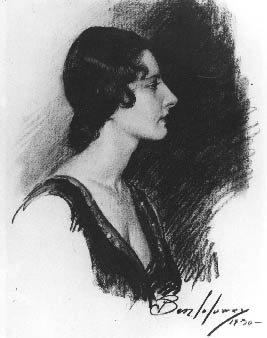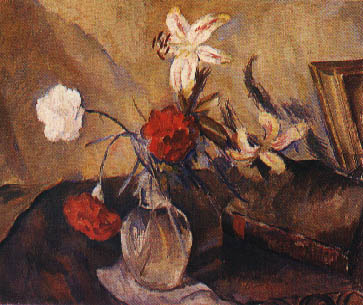When Ben Met Rae
A Story of Love At First Sight
In April 1930, Ben Solowey had been in New York for approximately a year and half. Fame and fortune had already knocked at his door, as his Theater Portraits were already a regular feature of the New York Times and Herald Tribune. His easel paintings were being shown at galleries and museums around the city.
For Rae Landis, a 24-year old woman born in Middletown, Pennsylvania and raised in Harrisburg, New York was an escape. Her hometown was a place so small, she later said, "that everyone knew what you were thinking, before you thought it." She had asked her mother repeatedly to let her move to the city and stay with her friend Anne Silver in the Bronx, and much to Rae's surprise, her mother one day responded to her pleas, "well, if you think you can handle it."

The first portrait of Rae
Charcoal on paper, 1930
This work was given to Rae's parents. Her mother later complained tha she got nly half of Rae since the portrait was in profile. While this is considered the first portrait, another appeared in a Harrisburg local paper, less than three weeks after Ben and Rae met.
|
She arrived in Manhattan on November 1, 1929, not the most precipitous day to arrive to make your fortune in the big city. The Stock Market Crash had only happened three days earlier. Rae later wrote that she got there in time to see people "walk out the windows into eternity." A family friend took her to the famous theater restaurant, Sardi's for lunch on her first day in New York. Little did she know that the people caricatured on the wall of Sardi's would become a part of her life.
Rae got secretarial work around town and her evenings were spent exploring the city. At a party on Fifth Avenue near Washington Square (near where she and Ben later lived), she went to a party where a tall, "lanky Dutchman," in Rae's words, pestered her for a date. She refused, but later wrote to her friend, the writer Helen Papashvilly, "How was I to know he would become the man of the moment?" The Dutchman turned out to be Willem DeKooning.
In February 1930 she went out for dinner with a family friend from Harrisburg, commercial artist Avrom Winfield. They were on the Upper West Side of Manhattan when Winfield suggested they stop by the studio of a friend, Ben Solowey. They rang the bell, but no one was home and they moved on.
Over one month later, April 5th, the scenario repeated itself, only this time Ben answered the bell. Rae did not know him, although had she picked up that day's New York Post she might have seen his striking portrait of Ina Bourskaya as Carmen at the Metropolitan Opera House.
Ben had just finished painting a still life, Carnation and Lilies, when his doorbell rang. He looked down the five flights of stairs and saw a his friend with a young lady and invited them up. They were not there very long when Ben asked Rae what she was doing the following evening. She was busy. But the night after she was free and the two made a date for dinner.
At dinner, Ben proposed. He told her he would have the first time they met except he did not think it

Carnation and Lilies
Oil on canvas, 1930
This is "jewel like still life" Rae refers to. Rae hung it in the house in the days after Ben died in 1978, and later wrote "It has become a part of me."
|
would be appropriate since she came with another man. This type of impulsiveness was unusual for Ben. He was not a paint-splattered, smock-wearing artist, nor did he fit any type of "crazy" artist stereotype. He was meticulous in his work and the details of his daily life, and fastidious in his appearance. He later told his nephew, Frank Hollin, that upon meeting Rae, he "knew what he wanted."
For Rae it was not the first proposal she had received. A demure and intelligent beauty, she attracted other men, including a local rabbi, who had asked for her hand in marriage, but she turned them down. She was no femme fatale, nor a tease. She simply did not want to be trapped into marriage simply because someone had asked, and she was old enough to say yes.
It took her a week to say yes to Ben. They were going to be married right away, but Ben's brother died suddenly so they waited a month. Rae's father, Moses Landis, a shopkeeper in Harrisburg, Pennsylvania, came to New York to meet the man who had asked for his daughter's hand. No doubt there was concern whether an artist could support Rae. On a handshake, Rae's father later declared that Ben was "all wool and a yard wide." Her mother did not meet Ben until the day of the wedding on June 8th.
Rae did not know that much about art. To this day, Harrisburg does not have an art museum. When first confronted by an El Greco at the Metropolitan Museum of Art, all she saw was her high school principal, Mr. Severance. She latter received, in her words "a liberal education" walking "museum miles" with Ben. She learned a great deal about art and what went into a good pose.
The latter was important because from the day they met, Rae became Ben's primary model. "Every artist does an occasional study of his mate," wrote artist Albert Gold in the catalogue for the 1979 Solowey retrospective at the Woodemere Art Museum, outside of Philadelphia, "but for Ben, Rae was woman-eternal."
For Ben and Rae it really was love at first sight. In a letter to her longtime friend, Helen Papashvilly, Rae tells the story in own style:
We were in the area of 72nd Street when he said, "Let’s stop and see my friend Ben Solowey" which we did do, only to have no one show! Nothing daunted, as they say, a month later, in the same general area, same routine but, an answering bell from Ben (his studio was on the 5th floor). Looking up from the ground one, through a maze of banister – there was Ben. In retrospect, and accustomed as I am to Ben’s present studio, in itself an artwork, created, if you will, by him, the 72nd Street one was rather — unobtrusive. On the easel, a jewel like still life. As we were leaving, he asked if I’d have dinner with him the next night, but I was doing something else. The next night? The magic sesame — at dinner — he asked me to marry him. Said he would done so the first night, except for this person’s presence! Difficult not to invoke the "what if" syndrome had Ben been off his premises the second time — that just might have been that!
Another portrait of Rae from 1930
Studio of Ben Solowey Home Page
Return to Studio Letter Home Page
© 2000 The Ben Solowey Collection. All Rights Reserved.

